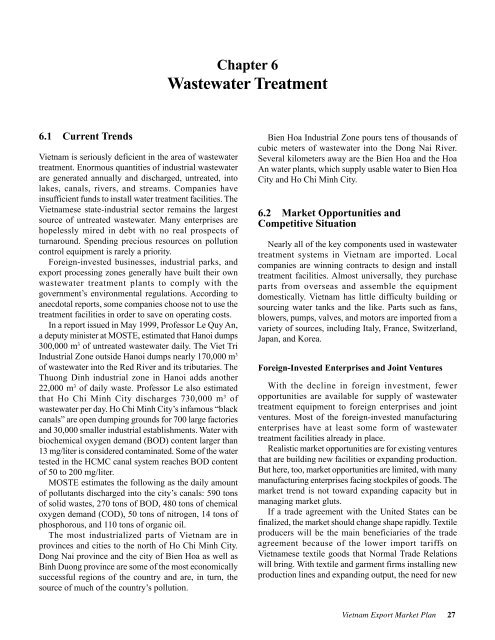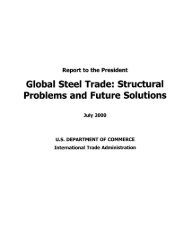Vietnam Environmental Technologies Export Market Plan
Vietnam Environmental Technologies Export Market Plan
Vietnam Environmental Technologies Export Market Plan
You also want an ePaper? Increase the reach of your titles
YUMPU automatically turns print PDFs into web optimized ePapers that Google loves.
Chapter 6<br />
Wastewater Treatment<br />
6.1—Current Trends<br />
<strong>Vietnam</strong> is seriously deficient in the area of wastewater<br />
treatment. Enormous quantities of industrial wastewater<br />
are generated annually and discharged, untreated, into<br />
lakes, canals, rivers, and streams. Companies have<br />
insufficient funds to install water treatment facilities. The<br />
<strong>Vietnam</strong>ese state-industrial sector remains the largest<br />
source of untreated wastewater. Many enterprises are<br />
hopelessly mired in debt with no real prospects of<br />
turnaround. Spending precious resources on pollution<br />
control equipment is rarely a priority.<br />
Foreign-invested businesses, industrial parks, and<br />
export processing zones generally have built their own<br />
wastewater treatment plants to comply with the<br />
government’s environmental regulations. According to<br />
anecdotal reports, some companies choose not to use the<br />
treatment facilities in order to save on operating costs.<br />
In a report issued in May 1999, Professor Le Quy An,<br />
a deputy minister at MOSTE, estimated that Hanoi dumps<br />
300,000 m 3 of untreated wastewater daily. The Viet Tri<br />
Industrial Zone outside Hanoi dumps nearly 170,000 m 3<br />
of wastewater into the Red River and its tributaries. The<br />
Thuong Dinh industrial zone in Hanoi adds another<br />
22,000 m 3 of daily waste. Professor Le also estimated<br />
that Ho Chi Minh City discharges 730,000 m 3 of<br />
wastewater per day. Ho Chi Minh City’s infamous “black<br />
canals” are open dumping grounds for 700 large factories<br />
and 30,000 smaller industrial establishments. Water with<br />
biochemical oxygen demand (BOD) content larger than<br />
13 mg/liter is considered contaminated. Some of the water<br />
tested in the HCMC canal system reaches BOD content<br />
of 50 to 200 mg/liter.<br />
MOSTE estimates the following as the daily amount<br />
of pollutants discharged into the city’s canals: 590 tons<br />
of solid wastes, 270 tons of BOD, 480 tons of chemical<br />
oxygen demand (COD), 50 tons of nitrogen, 14 tons of<br />
phosphorous, and 110 tons of organic oil.<br />
The most industrialized parts of <strong>Vietnam</strong> are in<br />
provinces and cities to the north of Ho Chi Minh City.<br />
Dong Nai province and the city of Bien Hoa as well as<br />
Binh Duong province are some of the most economically<br />
successful regions of the country and are, in turn, the<br />
source of much of the country’s pollution.<br />
Bien Hoa Industrial Zone pours tens of thousands of<br />
cubic meters of wastewater into the Dong Nai River.<br />
Several kilometers away are the Bien Hoa and the Hoa<br />
An water plants, which supply usable water to Bien Hoa<br />
City and Ho Chi Minh City.<br />
6.2—<strong>Market</strong> Opportunities and<br />
Competitive Situation<br />
Nearly all of the key components used in wastewater<br />
treatment systems in <strong>Vietnam</strong> are imported. Local<br />
companies are winning contracts to design and install<br />
treatment facilities. Almost universally, they purchase<br />
parts from overseas and assemble the equipment<br />
domestically. <strong>Vietnam</strong> has little difficulty building or<br />
sourcing water tanks and the like. Parts such as fans,<br />
blowers, pumps, valves, and motors are imported from a<br />
variety of sources, including Italy, France, Switzerland,<br />
Japan, and Korea.<br />
Foreign-Invested Enterprises and Joint Ventures<br />
With the decline in foreign investment, fewer<br />
opportunities are available for supply of wastewater<br />
treatment equipment to foreign enterprises and joint<br />
ventures. Most of the foreign-invested manufacturing<br />
enterprises have at least some form of wastewater<br />
treatment facilities already in place.<br />
Realistic market opportunities are for existing ventures<br />
that are building new facilities or expanding production.<br />
But here, too, market opportunities are limited, with many<br />
manufacturing enterprises facing stockpiles of goods. The<br />
market trend is not toward expanding capacity but in<br />
managing market gluts.<br />
If a trade agreement with the United States can be<br />
finalized, the market should change shape rapidly. Textile<br />
producers will be the main beneficiaries of the trade<br />
agreement because of the lower import tariffs on<br />
<strong>Vietnam</strong>ese textile goods that Normal Trade Relations<br />
will bring. With textile and garment firms installing new<br />
production lines and expanding output, the need for new<br />
<strong>Vietnam</strong> <strong>Export</strong> <strong>Market</strong> <strong>Plan</strong><br />
27
















